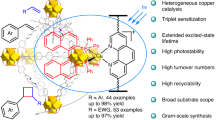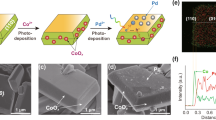Abstract
Natural photosynthesis uses the energy in sunlight to oxidize or reduce reaction centres multiple times, therefore preparing each reaction centre for a multiple-electron-transfer reaction that will ultimately generate stable reaction products. This process relies on multiple chromophores per reaction centre to quickly generate the active state of the reaction centre and to outcompete deleterious charge recombination. Using a similar design principle, we report spectroscopic evidence for the generation of a twice-oxidized TiO2-bound molecular proxy catalyst after low-intensity visible-light excitation of co-anchored molecular Ru(II)–polypyridyl dyes. Electron transfer from an excited dye to TiO2 generated a Ru(III) state that subsequently and repeatedly reacted with neighbouring Ru(II) dyes via self-exchange electron transfer to ultimately oxidize a distant co-anchored proxy catalyst before charge recombination. The largest yield for twice-oxidized proxy catalysts occurred when they were present at low coverage, suggesting that large dye/electrocatalyst ratios are also desired in dye-sensitized photoelectrochemical cells.
This is a preview of subscription content, access via your institution
Access options
Access Nature and 54 other Nature Portfolio journals
Get Nature+, our best-value online-access subscription
$29.99 / 30 days
cancel any time
Subscribe to this journal
Receive 12 print issues and online access
$259.00 per year
only $21.58 per issue
Buy this article
- Purchase on Springer Link
- Instant access to full article PDF
Prices may be subject to local taxes which are calculated during checkout


Similar content being viewed by others
References
Bard, A. J. & Fox, M. A. Artificial photosynthesis: solar splitting of water to hydrogen and oxygen. Acc. Chem. Res. 28, 141–145 (1995).
Vagnini, M. T. et al. Ultrafast photodriven intramolecular electron transfer from an iridium-based water-oxidation catalyst to perylene diimide derivatives. Proc. Natl Acad. Sci. USA 109, 15651–15656 (2012).
Du, P. & Eisenberg, R. Catalysts made of earth-abundant elements (Co, Ni, Fe) for water splitting: recent progress and future challenges. Energy Environ. Sci. 5, 6012–6021 (2012).
Hammarström, L. Accumulative charge separation for solar fuels production: coupling light-induced single electron transfer to multielectron catalysis. Acc. Chem. Res. 48, 840–850 (2015).
Han, Z., Qiu, F., Eisenberg, R., Holland, P. L. & Krauss, T. D. Robust photogeneration of H2 in water using semiconductor nanocrystals and a nickel catalyst. Science 338, 1321–1325 (2012).
Han, Z. & Eisenberg, R. Fuel from water: the photochemical generation of hydrogen from water. Acc. Chem. Res. 47, 2537–2544 (2014).
Das, A., Han, Z., Haghighi, M. G. & Eisenberg, R. Photogeneration of hydrogen from water using CdSe nanocrystals demonstrating the importance of surface exchange. Proc. Natl. Acad. Sci. USA 110, 16716–16723 (2013).
Ardo, S., Achey, D., Morris, A. J., Abrahamsson, M. & Meyer, G. J. Non-Nernstian two-electron transfer photocatalysis at metalloporphyrin–TiO2 interfaces. J. Am. Chem. Soc. 133, 16572–16580 (2011).
Youngblood, W. J. et al. Photoassisted overall water splitting in a visible light-absorbing dye-sensitized photoelectrochemical cell. J. Am. Chem. Soc. 131, 926–927 (2009).
McNamara, W. R. et al. Acetylacetonate anchors for robust functionalization of TiO2 nanoparticles with Mn(II)–terpyridine complexes. J. Am. Chem. Soc. 130, 14329–14338 (2008).
Xu, Y. et al. Synthesis and characterization of dinuclear ruthenium complexes covalently linked to RuII tris-bipyridine: an approach to mimics of the donor side of photosystem II. Chem. Eur. J. 11, 7305–7314 (2005).
Brimblecombe, R., Koo, A., Dismukes, G. C., Swiegers, G. F. & Spiccia, L. Solar driven water oxidation by a bioinspired manganese molecular catalyst. J. Am. Chem. Soc. 132, 2892–2894 (2010).
Song, W. et al. Photoinduced stepwise oxidative activation of a chromophore–catalyst assembly on TiO2 . J. Phys. Chem. Lett. 2, 1808–1813 (2011).
Moore, G. F. et al. A visible light water-splitting cell with a photoanode formed by codeposition of a high-potential porphyrin and an iridium water-oxidation catalyst. Energy Environ. Sci. 4, 2389–2392 (2011).
Klepser, B. M. & Bartlett, B. M. Anchoring a molecular iron catalyst to solar-responsive WO3 improves the rate and selectivity of photoelectrochemical water oxidation. J. Am. Chem. Soc. 136, 1694–1697 (2014).
Duan, L. et al. A molecular ruthenium catalyst with water-oxidation activity comparable to that of photosystem II. Nat. Chem. 4, 418–423 (2012).
Heyduk, A. F. & Nocera, D. G. Hydrogen produced from hydrohalic acid solutions by a two-electron mixed-valence photocatalyst. Science 293, 1639–1641 (2001).
Mann, K. R. et al. Solar energy storage. Production of hydrogen by 546-nm irradiation of a dinuclear rhodium(I) complex in acidic aqueous solution. J. Am. Chem. Soc. 99, 5525–5526 (1977).
Teets, T. S. & Nocera, D. G. Halogen photoreductive elimination from gold(III) centers. J. Am. Chem. Soc. 131, 7411–7420 (2009).
Karlsson, S. et al. Accumulative charge separation inspired by photosynthesis. J. Am. Chem. Soc. 132, 17977–17979 (2010).
Karlsson, S. et al. Accumulative electron transfer: multiple charge separation in artificial photosynthesis. Faraday Discuss. 155, 233–252 (2012).
Song, W. et al. Accumulation of multiple oxidative equivalents at a single site by cross-surface electron transfer on TiO2 . J. Am. Chem. Soc. 135, 11587–11594 (2013).
Song, W. et al. Visible light driven benzyl alcohol dehydrogenation in a dye-sensitized photoelectrosynthesis cell. J. Am. Chem. Soc. 136, 9773–9779 (2014).
Meyer, G. J. Antenna molecule drives solar hydrogen generation. Proc. Natl Acad. Sci. USA 112, 9146–9147 (2015).
Coggins, M. K., Zhang, M.-T., Chen, Z., Song, N. & Meyer, T. J. Single-site copper(II) water oxidation electrocatalysis: rate enhancements with HPO42− as a proton acceptor at pH 8. Angew. Chem. Int. Ed. 53, 12226–12230 (2014).
Alibabaei, L., Sherman, B. D., Norris, M. R., Brennaman, M. K. & Meyer, T. J. Visible photoelectrochemical water splitting into H2 and O2 in a dye-sensitized photoelectrosynthesis cell. Proc. Natl Acad. Sci. USA 112, 5899–5902 (2015).
Kanan, M. W. & Nocera, D. G. In situ formation of an oxygen-evolving catalyst in neutral water containing phosphate and Co2+. Science 321, 1072–1075 (2008).
Gao, Y. et al. Visible light driven water splitting in a molecular device with unprecedentedly high photocurrent density. J. Am. Chem. Soc. 135, 4219–4222 (2013).
Chang, D. W. et al. Bistriphenylamine-based organic sensitizers with high molar extinction coefficients for dye-sensitized solar cells. RSC Adv. 2, 6209–6215 (2012).
Mishra, A., Fischer, M. K. R. & Bäuerle, P. Metal-free organic dyes for dye-sensitized solar cells: from structure: property relationships to design rules. Angew. Chem. Int. Ed. 48, 2474–2499 (2009).
Ardo, S. & Meyer, G. J. Photodriven heterogeneous charge transfer with transition-metal compounds anchored to TiO2 semiconductor surfaces. Chem. Soc. Rev. 38, 115–164 (2009).
Göransson, E. et al. Charge transfer through cross-hyperconjugated versus cross-π-conjugated bridges: an intervalence charge transfer study. Chem. Sci. 4, 3522 (2013).
Staniszewski, A., Ardo, S., Sun, Y., Castellano, F. N. & Meyer, G. J. Slow cation transfer follows sensitizer regeneration at anatase TiO2 interfaces. J. Am. Chem. Soc. 130, 11586–11587 (2008).
Cappel, U. B., Gibson, E. A., Hagfeldt, A. & Boschloo, G. Dye regeneration by spiro-MeOTAD in solid state dye-sensitized solar cells studied by photoinduced absorption spectroscopy and spectroelectrochemistry. J. Phys. Chem. C 113, 6275–6281 (2009).
Ardo, S., Sun, Y., Staniszewski, A., Castellano, F. N. & Meyer, G. J. Stark effects after excited-state interfacial electron transfer at sensitized TiO2 nanocrystallites. J. Am. Chem. Soc. 132, 6696–6709 (2010).
Ardo, S., Sun, Y., Castellano, F. N. & Meyer, G. J. Excited-state electron transfer from ruthenium-polypyridyl compounds to anatase TiO2 nanocrystallites: evidence for a Stark effect. J. Phys. Chem. B 114, 14596–14604 (2010).
Cappel, U. B., Feldt, S. M., Schöneboom, J., Hagfeldt, A. & Boschloo, G. The influence of local electric fields on photoinduced absorption in dye-sensitized solar cells. J. Am. Chem. Soc. 132, 9096–9101 (2010).
O'Regan, B. C. & Durrant, J. R. Kinetic and energetic paradigms for dye-sensitized solar cells: moving from the ideal to the real. Acc. Chem. Res. 42, 1799–1808 (2009).
Schmidt-Mende, L., Kroeze, J. E., Durrant, J. R., Nazeeruddin, M. K. & Grätzel, M. Effect of hydrocarbon chain length of amphiphilic ruthenium dyes on solid-state dye-sensitized photovoltaics. Nano Lett. 5, 1315–1320 (2005).
Chandiran, A. K., Nazeeruddin, M. K. & Grätzel, M. The role of insulating oxides in blocking the charge carrier recombination in dye-sensitized solar cells. Adv. Funct. Mater. 24, 1615–1623 (2014).
Clifford, J. N., Yahioglu, G., Milgrom, L. R. & Durrant, J. R. Molecular control of recombination dynamics in dye sensitised nanocrystalline TiO2 films. Chem. Commun. 1260–1261 (2002).
Farnum, B. H., Wee, K.-R. & Meyer, T. J. Self-assembled molecular p/n junctions for applications in dye-sensitized solar energy conversion. Nat. Chem. 8, 845–852 (2016).
Walter, M. G. et al. Solar water splitting cells. Chem. Rev. 110, 6446–6473 (2010).
Sun, K. et al. Enabling silicon for solar-fuel production. Chem. Rev. 114, 8662–8719 (2014).
Song, W. et al. Visualization of cation diffusion at the TiO2 interface in dye sensitized photoelectrosynthesis cells (DSPEC). Energy Environ. Sci. 6, 1240–1248 (2013).
Sullivan, B. P., Salmon, D. J. & Meyer, T. J. Mixed phosphine 2,2′-bipyridine complexes of ruthenium. Inorg. Chem. 17, 3334–3341 (1978).
Liu, F. & Meyer, G. J. Remote and adjacent excited-state electron transfer at TiO2 interfaces sensitized to visible light with Ru(II) compounds. Inorg. Chem. 44, 9305–9313 (2005).
Behl, M., Hattemer, E., Brehmer, M. & Zentel, R. Tailored semiconducting polymers: living radical polymerization and NLO-functionalization of triphenylamines. Macromol. Chem. Phys. 203, 503–510 (2002).
Seok, W. K., Jo, M., Kim, N. & Yun, H. Comparative study of ruthenium (II) and ruthenium (III) complexes with the ligand dmbpy (dmbpy=4,4′-dimethyl-2,2′-bipyridine). Z. Anorg. Allg. Chem. 638, 754–757 (2012).
Connelly, N. G. & Geiger, W. E. Chemical redox agents for organometallic chemistry. Chem. Rev. 96, 877–910 (1996).
Acknowledgements
This work was supported by the School of Physical Sciences at the University of California Irvine and the National Science Foundation under CHE – 1566160. The authors acknowledge the UCI Laser Spectroscopy Facility (LSF) for transient absorption and photoluminescence spectroscopy instrumentations, the NMR Facility for NMR measurements, the Laboratory for Electron and X-ray Instrumentation (LEXI) for SEM measurements and the Mass Spectrometry Facility for ESI–MS measurements. The authors thank J. Cardon, who is supported by a National Science Foundation Graduate Research Fellowship, for performing additional control experiments during the review process. The authors also thank V. Nair for SEM measurements, D. Fishman, W. Van der Veer and A. Alshawa for assistance and guidance with the LSF instrumentation, J. Winkler for general laser and electronics guidance and H. Gray and A. Borovik for use of their laboratory space and their group members for support and guidance.
Author information
Authors and Affiliations
Contributions
S.A. conceived the research, wrote the Monte Carlo code and performed the Monte Carlo simulations. H.-Y.C. synthesized molecules and materials, prepared samples, performed measurements and analysed the data, with advice from S.A. S.A. and H.-Y.C. discussed the results and prepared the manuscript.
Corresponding author
Ethics declarations
Competing interests
The authors declare no competing financial interests.
Supplementary information
Supplementary information
Supplementary information (PDF 1859 kb)
Rights and permissions
About this article
Cite this article
Chen, HY., Ardo, S. Direct observation of sequential oxidations of a titania-bound molecular proxy catalyst generated through illumination of molecular sensitizers. Nature Chem 10, 17–23 (2018). https://doi.org/10.1038/nchem.2892
Received:
Accepted:
Published:
Issue Date:
DOI: https://doi.org/10.1038/nchem.2892
This article is cited by
-
Porous single-crystalline titanium dioxide at 2 cm scale delivering enhanced photoelectrochemical performance
Nature Communications (2019)
-
Caught in the act
Nature Chemistry (2018)






